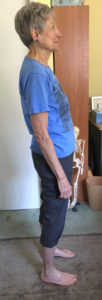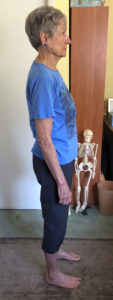Moving With Less Muscle Tension – 7/15/2019
If you are like me – A-type personality, over-achiever, compulsive DO-er – here is a discovery you may find useful for moving with less muscle tension.
Nutritious Movement and Restorative Exercise
I have been doing Restorative Exercises since I first met Katy Bowman in August 2009 when I was 71. I became an avid student attending 5-6 classes weekly. Then I did the Whole-Body Alignment RES (Restorative Exercise Specialist) certification program with Katy live and became certified in 2010. Then I became a teacher with Breena at the BEACH in 2013. And all this time, I have had an active home practice along with an ambitious walking, hiking, and hanging program. I am what you might call – into Nutritious Movement!
Neck Muscle Tension
About a year ago, I began experiencing voice and throat irritation – raspy voice, irritated throat, coughing and clearing my throat. These symptoms occurred while teaching restorative exercise, on the telephone, and in face to face conversations. Finally, I took six weeks off while going on a special diet to see if I had acid reflux. After ruling that out, the problem continued.
Addressing Muscle Tension – Alexander Technique (AT)
One day I got a telephone call from my chiropractor, Delia Gorey, in Ventura, California. She had worked on alleviating these issues and was puzzled that the symptoms persisted. Delia referred me to an Alexander Technique (AT) teacher and practitioner in Ventura. who she highly recommended – Sydney Laurel Harris.

In our first meeting Sydney gently used her hands to introduce me to the feeling of relaxing my neck. From there she led my head to go forward and up WITHOUT me DOING anything. She emphasized no effort on my part – NON-DOING. Just say the words silently, think/visualize as she delicately guided my neck and head.
She also worked with my breathing, again focusing on my neck and head, while lying on the AT table. She used only gentle guidance with her hands and verbal instruction. We both noticed excessive and chronic tension in my neck and shoulder muscles.
After the first appointment, I was at a total loss how to explain it to my husband and to myself. I had fully expected to come home with specific exercises to DO or at least something to DO. Not only was there nothing to DO, Sydney assured me if I forgot what she had said and done, no problem.
The second meeting was similar. Nothing for me to DO but experience my head poised on the top of my spine while silently saying the words and thinking/visualizing my head going forward and up. Her delicate hand guidance gave me the tactile cues. Slowly, I began to feel the muscles in my neck and shoulders relaxing. I began to freely move my head side to side.
Changing Muscle Tension
And, after the second session, I saw significant changes. I taught a full one-hour class of restorative exercise without coughing, no clearing my throat and no irritation. Following that, I had an hour-long phone conversation with my sister. At the end of our call, she commented she had heard none of the raspy throat issues usually present in our weekly calls. I told her what I was doing (non-doing) with the AT. I was still unable to explain what I experienced in my sessions with Sydney.
Learning More About AT – Body Learning by Michael Gelb
At our third meeting, I asked for a book recommendation so I could learn more. Sydney referred me to Body Learning by Michael Gelb which I found informative, inspirational and fascinating. I find myself returning to it frequently both for the text and photos.
The Over-Doer Learns More About Muscle Tension
At my ninth session, I began to reconcile the biomechanics I have learned from Katy with what I am learning from AT. In working diligently (read overworking) to ramp my chin to correct and limit further hyper-kyphosis, I had been tensing the muscles of my neck. This had compressed the space necessary for the free flow of my voice as I speak. My larynx was restricted causing constant irritation. With Sydney’s expert guidance and my “non-doing,” those muscles were able to relax allowing my head, neck and torso to naturally align.
Moving With Less Muscle Tension

Another instance of me over-working the Nutritious Movement restorative exercises was in my stance. My tendency is to enter a room with my belly first. This compresses my lumbar spine and puts strain on my knees and the balls of my feet. Again, I had worked diligently (read overdone) shifting my hips and weight back over my heels.

And still my default position had my hips forward. By focusing on undoing the unnecessary tension while non-doing, my torso shifted into a natural alignment and my knees relaxed.

In my experience, it is possible to OVERDO even a good thing if I add excessive tension to my body. Sydney and the Alexander Technique have provided me with a way to have it all. Now I can incorporate the non-doing of AT (feeling Sydney’s guidance, silently saying the words and thinking/visualizing my head going forward and up) with the restorative alignment exercises of Nutritious Movement. I can continue to change the way I move more by engaging more of my body with less muscle tension as I optimize dynamically aging.

WOW JOAN, all fixed. No drugs or equipment needed. Amazing what our bodies can do if allowed to repair on our own, if we only knew.
Glad to hear you have a new lease on more talk time in your life. I was worried you had used up your talk allowance.
I agree that you, Joan, epitomize dynamic and graceful aging! You’re my model!
I’m leaving for a family hiking/camping trip for almost a week and am packing my image of you as my inspiration. Even though I’ll be bringing up the rear it’s a joy-
ful event in Northern Calif.
What a marvellous pairing of Biomechanics and the Alexander Technique! And what a great reminder to allow the body to relax into something, rather than try to make it so. I’ve had a similar experience by pairing Hanna Somatics and Biomechanics, that is, if I do the Somatics first and follow with the Biomechanic correctives, the correctives are much easier to do because my body flows into them. But as a doer, it has taken me a lot of time to learn that less is more, and that allowing the body to relax into a pose or posture is far more welcoming and effective that trying too hard. Thanks for the posting.
I love this and find it so helpful! Pictures are worth a thousand words?
Brava Joan ! I am so happy for your new level of awareness!
I love reading how you are incorporating both of the languages to make the alignment work. More about undoing!
Brilliant. Undoing. cool. Glad you found the answer and a good answer at that!
Kudos!
Thank you so much for this informative post. I too have chronic neck tension. I even lie in bed with it! The non doing tip is so helpful.